Upgrading to an ultrawide monitor introduces a new level of immersion for gaming and productivity, but its size and weight present unique ergonomic challenges. A dedicated monitor arm is a crucial accessory that replaces the standard factory stand, offering superior adjustability, freeing up valuable desk space, and allowing for a more comfortable and efficient workspace. This guide provides an objective analysis of the factors involved in selecting the right arm and examines several models available on the market.
Understanding the Benefits of a Monitor Arm for Ultrawide Setups
The primary advantage of using a monitor arm, especially for a large display, is improved ergonomics. The ability to precisely control the height, depth, and angle of the screen helps align it with your eye level, reducing strain on the neck and shoulders. This is particularly important for ultrawide users who spend extended periods at their desks.
Beyond comfort, monitor arms reclaim the significant footprint that a standard ultrawide stand occupies. This newfound space can be used for other peripherals, documents, or simply to achieve a cleaner, more organized desk aesthetic. For those considering an ultrawide vs. regular monitor, the ability to easily manage the larger screen with an arm can be a deciding factor.

Key Considerations for Selecting an Ultrawide Monitor Arm
Choosing a monitor arm requires a careful evaluation of its specifications to ensure it can safely support your display and meet your ergonomic needs.
Weight and Screen Size Capacity
This is the most critical factor. The monitor arm must be explicitly rated to handle both the screen size (e.g., 34-inch, 49-inch) and, more importantly, the exact weight of your ultrawide monitor. Exceeding the weight capacity can lead to sagging, instability, or catastrophic failure.
VESA Compatibility Explained
The VESA Interface Standard is a set of guidelines for the mounting holes on the back of monitors. Most monitor arms adhere to this standard. Common VESA patterns are 75×75 mm and 100×100 mm. Before selecting an arm, confirm your monitor’s VESA pattern to ensure a direct fit. Some arms offer broader compatibility, such as 200×100 mm or 200×200 mm, for larger or heavier displays. If you’re wondering, “Can you mount a computer monitor on the wall?“, the same VESA principles apply.
Range of Motion: Tilt, Swivel, and Rotation
- Tilt: Allows you to angle the screen up or down, which is useful for reducing glare and achieving the correct vertical viewing angle.
- Swivel: Allows you to turn the screen left or right, which is ideal for sharing your view with others or adjusting to different seating positions.
- Rotation: Enables you to pivot the screen between landscape and portrait orientations. While less common for ultrawides, it can be a useful feature for specific tasks like coding or document viewing on a secondary, vertical monitor.
Mounting Mechanisms: C-Clamp vs. Grommet
- C-Clamp: This is the most common mounting type. It clamps onto the edge of your desk without requiring any permanent modification. It’s essential to check the maximum desk thickness the clamp can accommodate.
- Grommet: This method involves mounting the arm through a hole in the desk surface. It provides a very secure and clean installation but requires drilling if a pre-existing cable management hole is not available.
Build Materials and Durability
Monitor arms are typically constructed from steel, aluminum, or a combination of both. Aluminum arms are often lighter and may feature a more modern aesthetic, while steel provides exceptional strength and rigidity, which is crucial for supporting heavy ultrawide monitors.
Integrated Cable Management
An effective cable management system, which usually consists of channels or clips along the arm, helps to route display and power cables out of sight. This contributes to a tidy and professional-looking setup by preventing cable clutter.
Comparison of Selected Monitor Arms for Ultrawide Screens
This table offers an at-a-glance comparison of the key specifications for the five models analyzed in this guide.
| Feature | Ergotron LX | WALI Single Gas Spring | VIVO Premium Aluminum | AVLT Single 13″-38″ | Monoprice Ultrawide |
| Max Screen Size | 34″ | 35″ | 49″ | 38″ | 49″ |
| Max Weight Capacity | 25 lbs (11.3 kg) | 33 lbs (15 kg) | 33 lbs (15 kg) | 31 lbs (14 kg) | 33 lbs (15 kg) |
| VESA Compatibility | 75×75, 100×100 mm | 75×75, 100×100 mm | 75×75, 100×100 mm | 75×75, 100×100 mm | 75×75, 100×100, 200×100, 200×200 mm |
| Tilt Range | +70° / -5° | +45° / -45° | +45° / -45° | +90° / -90° | +15° / -15° |
| Swivel Range | 360° | 180° (+90° / -90°) | 180° (+90° / -90°) | 360° | 90° (+45° / -45°) |
| Rotation | 360° | 180° (+90° / -90°) | 180° | 360° | Not Specified |
| Mounting Type | C-Clamp & Grommet | C-Clamp & Grommet | C-Clamp & Grommet | C-Clamp & Grommet | C-Clamp & Grommet |
| Material | Aluminum | Steel / Aluminum | Aluminum | Aluminum / Steel | Steel / Aluminum |
| Primary Mechanism | Mechanical Spring | Gas Spring | Gas Spring | Gas Spring | Not Specified |
Detailed Analysis of 5 Ultrawide Monitor Arms
The following sections provide a functional breakdown of five monitor arm models, focusing on their specifications and intended use cases.
Ergotron LX Single Monitor Arm
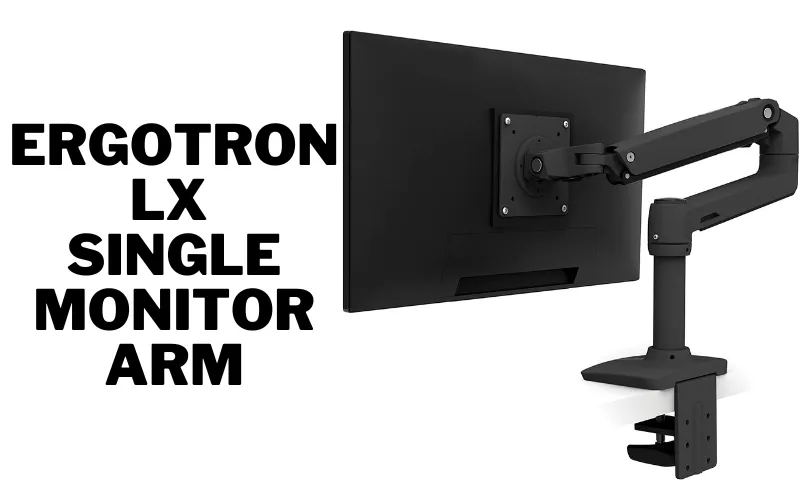
Key Specifications
- Material: Aluminum
- Max Screen Size: 34 inches
- Max Weight Capacity: 25 lbs (11.3 kg)
- VESA Compatibility: 75×75 mm, 100×100 mm
- Adjustability: 360° rotation, 75° tilt
Functional Analysis
The Ergotron LX utilizes a polished aluminum construction and a mechanical spring system known as Constant Force™ technology. This design facilitates smooth, light-touch adjustments across its range of motion. The arm provides extensive height adjustment and can be folded back over its base to clear the workspace. It includes both a desk clamp (for surfaces 0.4″ to 2.4″ thick) and a grommet mount, offering versatile installation options. The cable management system routes cables beneath the arm for a clean appearance.
Suitability
This model is well-suited for users with ultrawide monitors up to 34 inches and weighing no more than 25 pounds. Its fluid motion and robust build quality make it a reliable choice for professionals who frequently reposition their display throughout the day.
WALI Single Monitor Gas Spring Desk Mount
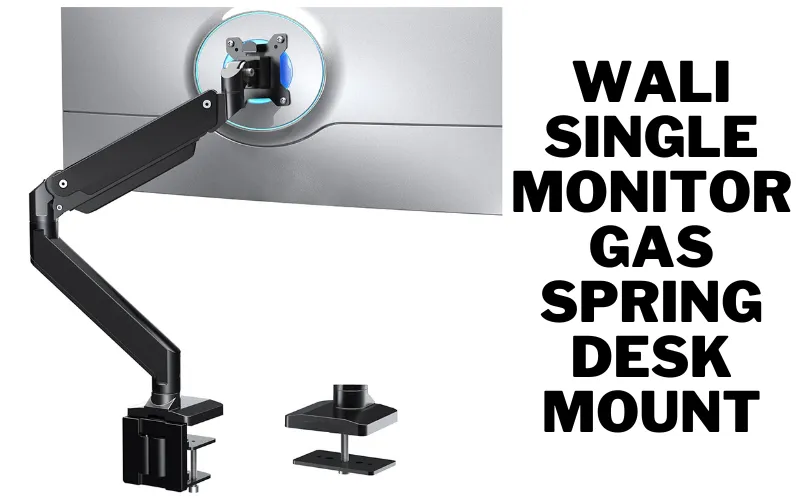
Key Specifications
- Material: High-grade steel and aluminum
- Max Screen Size: 35 inches
- Max Weight Capacity: 33 lbs (15 kg)
- VESA Compatibility: 75×75 mm, 100×100 mm
- Adjustability: +45°/-45° tilt, +90°/-90° swivel, +90°/-90° rotation
Functional Analysis
The WALI mount employs a gas spring mechanism to counterbalance the monitor’s weight, allowing for smooth height and position adjustments. It features a higher weight capacity than the Ergotron LX, making it suitable for heavier 35-inch displays. Its two-stage locking system accommodates both C-clamp (up to 3.3″ thick) and grommet base installations. The VESA plate is detachable for easier monitor mounting, and the arm includes channels for hiding cables.
Suitability
This arm is a practical option for users needing to support monitors up to 35 inches and 33 pounds. The gas spring system is beneficial for those who prefer effortless height adjustments. The flexibility in tilt, swivel, and rotation serves a wide range of tasks, from standard work to content creation. This type of functionality is also seen in some best dual monitor stand models, showing the versatility of the technology.
VIVO Premium Aluminum Extended Monitor Arm
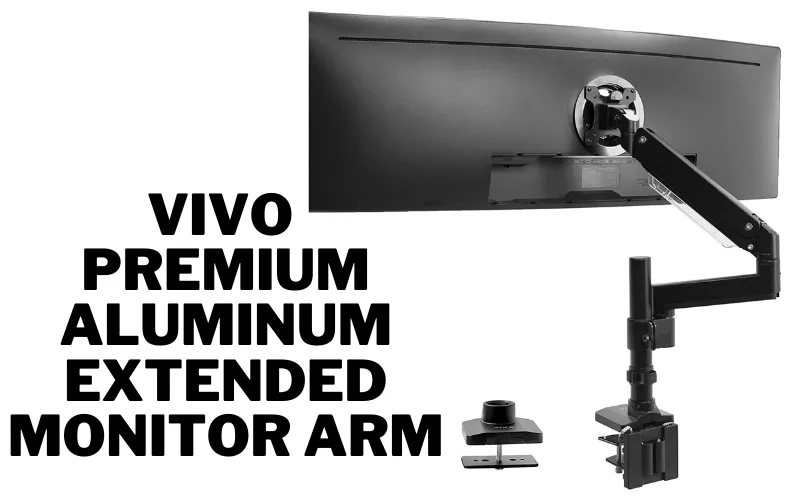
Key Specifications
- Material: Aluminum
- Max Screen Size: 49 inches
- Max Weight Capacity: 33 lbs (15 kg)
- VESA Compatibility: 75×75 mm, 100×100 mm
- Adjustability: +45°/-45° tilt, 180° swivel, 180° rotation
Functional Analysis
The VIVO arm is designed to support larger and heavier ultrawide screens, up to 49 inches, provided they are within the 33-pound weight limit. It features a pneumatic spring for height adjustment and includes a tension adjustment bolt to correctly counterbalance the monitor’s weight. The arm is mounted on a 13-inch pole, which provides a significant range of potential height settings. It includes both C-clamp and grommet mounting hardware and features a removable VESA plate for simplified installation.
Suitability
This model is specifically targeted at users of larger ultrawide monitors, including some 49-inch models. Its primary strengths are its high weight capacity and extended height adjustability, making it ideal for creating an ergonomic setup with very large screens. For users considering a multi-monitor wall setup, a best dual monitor wall mount might be an alternative solution.
AVLT Single 13″-38″ Monitor Arm Desk Mount
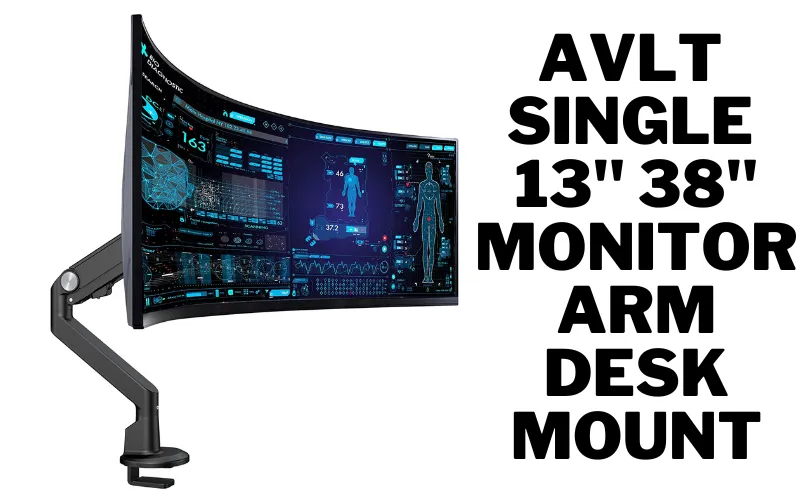
Key Specifications
- Material: Aluminum and high-grade steel
- Max Screen Size: 38 inches
- Max Weight Capacity: 31 lbs (14 kg)
- VESA Compatibility: 75×75 mm, 100×100 mm
- Adjustability: 360° swivel, extensive tilt and rotation
Functional Analysis
The AVLT monitor arm is engineered for heavy-duty use, supporting both flat and curved monitors up to 38 inches and 31 pounds. Its gas spring mechanism has been tested for 10,000 motion cycles, indicating a focus on durability. The arm provides a wide range of motion, including full 360-degree swivel and rotation, allowing for portrait or landscape orientation. The C-clamp mount is equipped with anti-scratch pads to protect the desk surface. The quick-release VESA plate system is designed for robust and simple monitor attachment.
Suitability
This arm is a strong candidate for users with mid-to-large ultrawide monitors (up to 38 inches) who require a full range of motion. The durable construction and tested gas spring make it suitable for environments where frequent and varied adjustments are necessary, such as in a gaming or professional design workspace. The needs of a sim racing setup might also be met by such a versatile arm.
Monoprice Ultrawide Monitor Mount
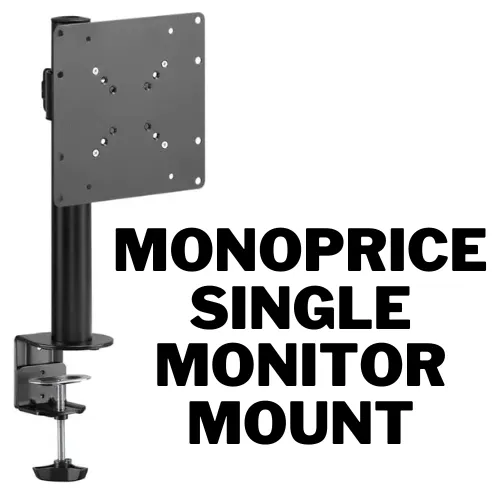
Key Specifications
- Material: Steel and aluminum
- Max Screen Size: 49 inches
- Max Weight Capacity: 33 lbs (15 kg)
- VESA Compatibility: 75×75, 100×100, 200×100, 200×200 mm
- Adjustability: +15°/-15° tilt, +45°/-45° swivel
Functional Analysis
The Monoprice mount stands out for its broad VESA compatibility, which includes the 200×100 mm and 200×200 mm patterns not commonly found on other arms in this category. This makes it uniquely suited for certain large or non-standard displays. It is built to handle screens up to 49 inches and 33 pounds. While its tilt and swivel ranges are more limited compared to other models, it provides the core adjustments needed for ergonomic positioning. It includes both clamp and grommet installation options and has integrated cable management.
Suitability
This mount is the optimal choice for users whose large ultrawide monitors require a 200×100 mm or 200×200 mm VESA pattern. While it offers less fine-tuned articulation, its heavy-duty build and expanded compatibility address a specific but important market segment.
Expert Takeaway: When choosing a monitor arm, always verify your monitor’s weight and VESA pattern first. These two specifications are non-negotiable and will be the primary determinants of which arm is appropriate for your equipment.
Frequently Asked Questions (FAQ)
How can I determine if my ultrawide monitor is VESA compatible?
To check for VESA compatibility, examine the back of your monitor. If it is compatible, you will see a square or rectangular pattern of four screw holes. The distance between these holes, measured in millimeters (e.g., 100mm x 100mm), is the VESA pattern. This information is also listed in your monitor’s user manual or on the manufacturer’s product page.
Can a heavy-duty monitor arm damage a desk?
If installed correctly on a suitable desk, a monitor arm should not cause damage. However, mounting a heavy ultrawide monitor on a very thin or low-quality desk (e.g., particleboard with a hollow core) can cause the surface to bend or break. For thin desks, using a steel reinforcement plate (sold separately) under the desk can help distribute the pressure from the C-clamp and prevent damage.
What is the functional difference between gas spring and mechanical spring arms?
Gas spring arms use a pressurized cylinder to counterbalance the monitor’s weight, typically resulting in smoother, more effortless vertical adjustments. Mechanical spring arms use a coiled spring and often require more manual force to adjust, but they are known for their long-term durability and reliability.
Do monitor arms offer benefits for a gaming setup?
Yes. While a monitor arm will not directly impact FPS or graphical performance, it provides significant ergonomic benefits for long gaming sessions. Proper monitor height and distance can reduce eye and neck fatigue, leading to greater comfort and focus. The ability to easily move the monitor closer for immersive games or push it back for other tasks is a key advantage for any versatile PC gaming setup.
How long can one expect a quality monitor arm to last?
A well-constructed monitor arm from a reputable brand can last for many years, often well over five to ten years. The lifespan primarily depends on the quality of the internal mechanism (gas or mechanical spring) and the build materials. Components like the tension spring may eventually wear, but high-quality arms are designed for thousands of adjustment cycles. Before any issues arise with the arm, you might find yourself asking, “When should you upgrade your motherboard?” or other components first.

With 15 years of experience as a PC hardware technician, Ben brings a practical, hands-on approach to our PC Components section. He specializes in real-world testing and longevity analysis, explaining how components perform over time. His guides help readers understand the practical side of owning and maintaining a gaming PC.
